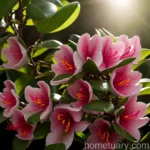The Beautiful Evergreen Azalea (Rhododendron ‘Herbert’)
Introduction to Evergreen Azalea
The evergreen azalea, also known as Rhododendron ‘Herbert,’ is a stunning flowering plant that belongs to the genus Rhododendron, and it is renowned for its vibrant and abundant blooms. With its mesmerizing colors and delightful fragrance, the evergreen azalea has become a favorite among plant enthusiasts and gardeners alike.
Key Takeaways – Evergreen Azalea (Rhododendron ‘Herbert’)
- Plant Name: Evergreen Azalea (Rhododendron ‘Herbert’)
- Family: Ericaceae
- Water: Keep moist but well-drained soil
- Sunlight: Partial shade to full sun
- Fertilizer: Acidic fertilizer
- Soil: Well-draining, acidic soil
- Pruning: Regular pruning after flowering
- Propagation: Cuttings and layering
- Container: Suitable for container planting
- Common Diseases: Leaf Spot, Powdery Mildew
- Common Pests: Lace Bugs, Spider Mites
What is Plant: Evergreen Azalea (Rhododendron ‘Herbert’)?
The evergreen azalea, scientifically known as Rhododendron ‘Herbert,’ is a compact, slow-growing shrub that can reach a height and spread of about 2 to 3 feet. This plant features glossy, dark green foliage and produces an abundance of showy, trumpet-shaped flowers. The blooming period for evergreen azalea typically occurs in spring, though some varieties may have a blooming season that extends into the summer.
Evergreen azaleas are cherished for their ability to thrive in shady areas of the garden, making them a popular choice for adding a splash of color to woodland settings. Their exquisite flowers come in a wide range of vibrant hues, including shades of pink, red, white, purple, and bi-colors, which adds a captivating allure to any landscape.
Culture
The culture of evergreen azaleas encompasses various aspects of their care and growth requirements, including watering, sunlight exposure, soil preferences, and fertilizer needs. By understanding and adhering to the optimal cultural practices, gardeners can ensure the health and vitality of these stunning shrubs.
Uses
Evergreen azaleas are highly versatile and can be utilized in a multitude of ways to enhance the beauty of a garden or landscape. Some common uses include:
- Foundation Plantings: Their compact size and lush foliage make them ideal for framing the base of a building or structure.
- Borders and Edgings: Evergreen azaleas create captivating borders and edgings along pathways, driveways, or garden beds.
- Woodland Gardens: Due to their preference for partial shade, they are perfect for adding color to shaded areas and woodland landscapes.
- Containers: Their ability to thrive in containers makes them an excellent choice for patios, balconies, and small outdoor spaces.
Water
Maintaining adequate moisture levels in the soil is crucial for the health and vitality of evergreen azaleas. While they require consistent moisture, it is important to avoid overwatering, as waterlogged soil can lead to root rot and other detrimental conditions. During periods of hot or dry weather, it is essential to monitor the soil moisture and water the plants accordingly.
Sunlight
Evergreen azaleas thrive in partially shaded locations, though they can also tolerate full sunlight, especially in cooler climates. When planting evergreen azaleas, it is advisable to select a site that offers dappled sunlight or morning sun with afternoon shade. This ensures that the plants receive the appropriate light conditions for optimal growth and abundant flowering.
Fertilizer
To promote healthy growth and prolific blooms, evergreen azaleas benefit from regular applications of a specialized acidic fertilizer designed for acid-loving plants. These fertilizers are typically formulated to provide essential nutrients while maintaining the acidic pH levels that azaleas prefer. When applying fertilizer, it is important to follow the recommended dosage and timing to avoid overfeeding or damaging the plants.
Soil
Evergreen azaleas thrive in well-draining, acidic soil that is rich in organic matter. A slightly acidic soil with a pH range of 4.5 to 6.0 is ideal for these plants. Gardeners can adjust the soil pH by incorporating organic materials such as peat moss, pine bark, or compost. Additionally, mulching with acidic materials helps in retaining soil moisture and maintaining the desired pH levels.
Pruning
Pruning plays a vital role in maintaining the shape, health, and flowering potential of evergreen azaleas. The ideal time for pruning these shrubs is shortly after the blooming period, typically in late spring or early summer. By removing spent flowers and selectively trimming back overgrown or wayward branches, gardeners can encourage a compact growth habit and stimulate the development of new buds for the following season.
Propagation
Propagation of evergreen azaleas can be achieved through several methods, including:
- Cuttings: Taking stem cuttings during the growing season and rooting them under controlled conditions.
- Layering: Encouraging the development of roots on a low-hanging branch that remains attached to the parent plant, eventually allowing it to be severed and transplanted.
Container Popularity
The compact size, attractive foliage, and vibrant blooms of evergreen azaleas make them popular choices for container gardening. Whether grown on a patio, balcony, or terrace, these charming shrubs add an element of beauty and elegance to outdoor spaces. When selecting containers for evergreen azaleas, it is important to choose options that provide adequate drainage and sufficient space for the plants’ roots to expand.
Common Diseases
Despite their resilience, evergreen azaleas are susceptible to certain diseases that can affect their overall health and appearance. Recognizing the symptoms and implementing appropriate measures for disease prevention and control is essential in maintaining the vigor of these plants.
Disease Diagnosis
Two of the most common diseases that affect evergreen azaleas are:
- Leaf Spot: This fungal disease manifests as dark spots on the foliage, eventually leading to leaf yellowing and premature shedding.
- Powdery Mildew: Characterized by a powdery white coating on the leaves, powdery mildew can distort the foliage and inhibit the plant’s growth.
To diagnose these diseases, it is important to closely inspect the leaves and stems for any signs of discoloration, spots, or unusual growth. Early detection allows for prompt intervention and treatment to prevent the spread of the diseases.
Common Pests
In addition to diseases, evergreen azaleas may also fall victim to various pests that can compromise their health and vitality. Understanding the common pests and their control methods is essential for safeguarding these plants against infestations.
Botanist’s Tips
As a botanist specializing in the cultivation of evergreen azaleas, here are some valuable tips for ensuring the optimal growth and blooming of these exquisite shrubs:
- Regular Monitoring: Keep a close eye on the plants for any signs of diseases, pests, or nutrient deficiencies. Early intervention is key to preventing severe issues.
- Mulching: Apply a layer of acidic mulch around the base of the plants to retain moisture, suppress weeds, and promote a favorable soil environment.
- Seasonal Maintenance: Schedule regular maintenance tasks such as pruning, fertilization, and mulch renewal to support the long-term health of the evergreen azaleas.
- Proper Watering: Pay attention to the moisture levels in the soil, particularly during hot and dry periods, to prevent drought stress and maintain optimal hydration.
- Soil pH Testing: Periodically test the soil pH to ensure that it remains within the preferred acidic range for evergreen azaleas, and make adjustments as needed.
Fun Facts
- The evergreen azalea is a favored choice for traditional Japanese gardens, where its vibrant blooms symbolize beauty and transient nature.
- In the language of flowers, azaleas are associated with expressions of love and devotion, making them popular gifts for special occasions.
- Evergreen azaleas belong to the genus Rhododendron, which includes a diverse array of species, cultivars, and hybrids with varying growth habits and flower forms.
Links to External Resources
For further information on evergreen azalea care, planting guides, fertilizer recommendations, and more, consider exploring the following resources:
- American Rhododendron Society
- The Azalea Society of America
- Royal Horticultural Society – Growing Rhododendrons and Azaleas
By leveraging the insights and expertise offered by reputable organizations and horticultural experts, you can enhance your knowledge and proficiency in cultivating evergreen azaleas with confidence.
In this comprehensive guide, we’ve delved into the fascinating realm of evergreen azaleas, uncovering the nuances of their care, cultivation, and the myriad delights they bring to the garden. Through diligent attention to their water, sunlight, soil, and nutrient needs, alongside proactive measures for disease and pest management, gardeners can revel in the vibrant beauty and enduring allure of Rhododendron ‘Herbert’ and its charming counterparts. With the right knowledge and dedication, the experience of growing evergreen azaleas can be immensely rewarding, imparting a touch of natural splendor and enchantment to any outdoor space.















